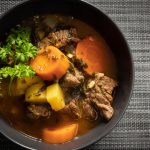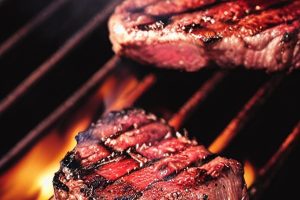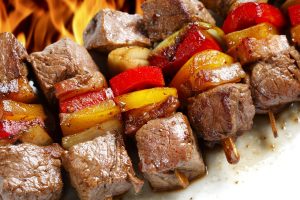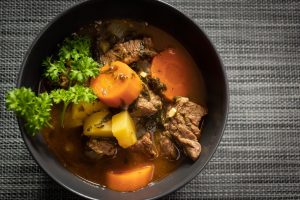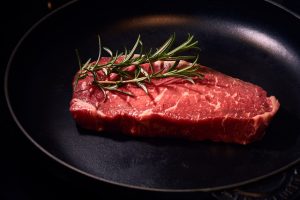Exploring Fusion Flavors: Modernizing the Classic Moo Shu Beef
Fusion cuisine has become increasingly popular in recent years, as chefs and food enthusiasts seek to combine different flavors from various culinary traditions. One such fusion flavor that has gained traction is the modernization of the classic Moo Shu Beef dish. This delectable Chinese dish has been infused with contemporary ingredients and techniques, resulting in a unique and tantalizing experience for the palate.
Traditionally, Moo Shu Beef consists of stir-fried beef, typically flank steak, mixed with a medley of vegetables such as cabbage, mushrooms, and bamboo shoots. The dish is then seasoned with soy sauce, hoisin sauce, and other traditional Chinese condiments. The mixture is traditionally served with thin pancakes, allowing diners to wrap the flavorful filling in a delightful handheld package.
However, with the advent of fusion flavors, chefs have been experimenting with different ingredients and cooking methods to create a modern twist on this classic dish. One popular variation is the addition of Korean barbecue flavors to the beef. By marinating the beef in a blend of soy sauce, sesame oil, garlic, and ginger, chefs are able to infuse the meat with a rich and savory taste that adds a new dimension to the dish.
In addition to the beef, modernized Moo Shu dishes often feature a wider variety of vegetables than the traditional version. Chefs may include ingredients like bell peppers, snap peas, and even exotic mushrooms to enhance the overall flavor profile. This not only adds visual appeal to the dish but also provides a diverse range of textures and tastes.
Furthermore, fusion flavors often incorporate new cooking techniques to elevate the dish. For example, instead of stir-frying the beef and vegetables separately, chefs may opt for grilling the beef for a smoky flavor and roasting the vegetables to bring out their natural sweetness. These techniques not only add depth to the dish but also create a more visually appealing presentation.
The sauces used in modernized Moo Shu Beef are also given a contemporary twist. Chefs may experiment with different combinations of condiments, such as adding a touch of sriracha for a spicy kick or incorporating Asian-inspired barbecue sauces for a tangy flavor. These innovative sauces complement the other ingredients and bring an element of surprise to the dish.
Overall, the modernization of the classic Moo Shu Beef dish through fusion flavors has resulted in a culinary experience that combines traditional Chinese elements with contemporary twists. By incorporating new ingredients, cooking techniques, and sauces, chefs have created a dish that is both visually appealing and bursting with complex flavors. Whether you are a fan of traditional Chinese cuisine or a food enthusiast looking to explore new flavors, a taste of modernized Moo Shu Beef is sure to leave you satisfied and craving for more.
Infusing Global Flavors: Reinventing Traditional Moo Shu Beef
Moo Shu Beef is a traditional Chinese dish that has been enjoyed for centuries. With its combination of tender beef, fresh vegetables, and flavorful sauce, it has become a staple in Chinese cuisine. However, in recent years, there has been a growing trend of infusing global flavors into traditional dishes, and Moo Shu Beef is no exception.
Chefs all over the world are reinventing the classic Moo Shu Beef by incorporating different ingredients and techniques from various cuisines. This infusion of global flavors not only adds a modern twist to the dish but also introduces new and exciting flavors to the palate.
One popular way of reinventing Moo Shu Beef is by incorporating Mexican flavors. Chefs are replacing the traditional pancakes used to wrap the beef and vegetables with soft flour tortillas. This gives the dish a more familiar and comforting taste, reminiscent of a classic Mexican burrito. Additionally, they are adding ingredients such as salsa, guacamole, and shredded cheese, which complement the flavors of the beef and vegetables perfectly.
Another approach to infusing global flavors into Moo Shu Beef is by incorporating Middle Eastern spices and ingredients. Chefs are adding spices such as cumin, coriander, and paprika to the beef, giving it a rich and aromatic flavor. They are also incorporating ingredients like tahini sauce and pomegranate molasses, which add a tangy and sweet element to the dish. These Middle Eastern flavors provide a unique and exotic twist to the traditional Moo Shu Beef.
Furthermore, chefs are experimenting with Korean flavors to reinvent Moo Shu Beef. They are incorporating ingredients such as kimchi, gochujang (Korean chili paste), and sesame oil to add a spicy and savory kick to the dish. These Korean flavors add depth and complexity to the traditional flavors of Moo Shu Beef, creating a truly unique and unforgettable dining experience.
In conclusion, the infusion of global flavors into traditional Moo Shu Beef is a trend that is gaining popularity in the culinary world. Chefs are reinventing this classic Chinese dish by incorporating Mexican, Middle Eastern, and Korean flavors, creating a fusion of tastes that excite and delight the palate. Whether it’s the familiar flavors of Mexico, the exotic spices of the Middle East, or the fiery kick of Korean cuisine, these reinvented Moo Shu Beef dishes offer a new and exciting twist on a beloved classic.
Spicing up the Traditional: Adding a Contemporary Twist to Moo Shu Beef
Moo Shu Beef is a classic Chinese dish that has been enjoyed for centuries. With its flavorful combination of tender beef, crisp vegetables, and rich hoisin sauce, it is no wonder that this dish has stood the test of time. However, if you are looking to add a contemporary twist to this traditional recipe, we have some delicious ideas that will elevate your dining experience.
One way to give your Moo Shu Beef a modern flair is to experiment with different cuts of beef. While the traditional recipe calls for thinly sliced beef, you can try using a different cut, such as flank steak or even filet mignon, for a more upscale twist. The tender, juicy texture of these cuts will add a luxurious touch to your dish.
Another way to add a contemporary twist is to play with the vegetables in your Moo Shu Beef. While the original recipe typically includes cabbage, mushrooms, and carrots, you can incorporate more exotic options like bok choy, snow peas, or even kale. These greens will not only add vibrant colors to your dish but also provide a fresh and nutritious element.
Additionally, consider experimenting with the sauce. While hoisin sauce is a staple in traditional Moo Shu Beef, you can try adding other flavors to create a unique twist. For a spicy kick, mix in some sriracha or chili paste. Alternatively, for a tangy twist, add a splash of lime juice or rice vinegar. These small additions can transform the flavor profile of your dish and give it a contemporary edge.
Lastly, consider presenting your Moo Shu Beef in a more modern and visually appealing way. Traditionally, the dish is served with pancakes or tortillas for wrapping the beef and vegetables. However, you can switch it up by using lettuce cups or even serving the components separately, allowing your guests to build their own customized wraps. This interactive dining experience adds an element of fun and creativity to the meal.
In conclusion, by experimenting with different cuts of beef, incorporating unique vegetables, playing with the sauce, and presenting the dish in a contemporary way, you can add a fresh and exciting twist to the traditional Moo Shu Beef. These simple changes will not only elevate the flavor and presentation but also provide a memorable dining experience for you and your guests. So go ahead and get creative in the kitchen – your taste buds will thank you!
Embracing Fusion Cuisine: Elevating Moo Shu Beef with Modern Flavors
Fusion cuisine has become a popular trend in the culinary world, as chefs and food enthusiasts are constantly seeking to combine different culinary traditions and flavors to create unique and exciting dishes. One such example is the fusion of traditional Chinese moo shu beef with modern flavors, resulting in a delightful and elevated culinary experience.
Moo shu beef is a classic Chinese dish that typically consists of stir-fried beef, mushrooms, and other vegetables, wrapped in thin pancakes and served with hoisin sauce. While this traditional version is delicious in its own right, embracing fusion cuisine allows for the incorporation of modern flavors to take this dish to a whole new level.
To elevate moo shu beef, one can experiment with adding ingredients such as truffle oil, cilantro, or even kimchi. These additions bring an unexpected twist to the dish, providing a unique and memorable dining experience. Truffle oil, for example, adds a luxurious and earthy flavor to the beef, enhancing its richness. Cilantro, on the other hand, provides a fresh and herbaceous note, balancing out the savory elements of the dish. And for those who enjoy a spicy kick, kimchi brings a tangy and fiery flavor that perfectly complements the beef.
In addition to exploring new flavors, the presentation of moo shu beef can also be modernized. Instead of serving it in the traditional pancake wrap, one can present the dish deconstructed, allowing diners to assemble their own moo shu beef creations. This interactive approach adds an element of fun and customization to the dining experience, further enhancing the fusion concept.
When it comes to embracing fusion cuisine and elevating traditional dishes like moo shu beef, it is important to maintain a formal and informative tone. This style of writing allows the information to be presented in a clear and concise manner, ensuring that the reader understands the purpose and potential of incorporating modern flavors into this classic Chinese dish.
In conclusion, fusion cuisine offers a world of possibilities for elevating traditional dishes such as moo shu beef. By incorporating modern flavors like truffle oil, cilantro, or kimchi, and presenting the dish in a unique and interactive way, chefs and food enthusiasts can create an unforgettable dining experience. Embracing fusion cuisine allows for the exploration of new culinary horizons, pushing the boundaries of traditional recipes and delighting the taste buds of those seeking something extraordinary.
From East to West: Incorporating Fusion Flavors in Moo Shu Beef
Moo Shu Beef is a classic Chinese dish that originated in Northern China. It is known for its tender strips of beef, sautéed with vegetables and wrapped in thin pancakes. However, in recent years, there has been a growing trend of incorporating fusion flavors into traditional dishes. This article will explore some exciting fusion flavors that can be incorporated into Moo Shu Beef, taking it from East to West.
One popular fusion flavor to consider is the addition of Mexican spices. By infusing the beef with a blend of cumin, chili powder, and oregano, you can give your Moo Shu Beef a spicy kick reminiscent of Mexican cuisine. This fusion flavor adds a depth of flavor and a touch of heat that pairs well with the crispness of the vegetables and the softness of the pancakes.
Another fusion flavor to explore is the use of Korean barbecue sauce. By marinating the beef in a sweet and savory Korean barbecue sauce, you can add a tangy and smoky flavor to your Moo Shu Beef. This fusion flavor creates a unique combination of tastes that will surprise and delight your taste buds. The boldness of the barbecue sauce complements the freshness of the vegetables and adds an extra layer of complexity to the dish.
For those who enjoy Mediterranean flavors, incorporating Greek seasoning into Moo Shu Beef can be a great option. By seasoning the beef with a blend of oregano, garlic, and lemon zest, you can infuse it with the bright and fresh flavors of the Mediterranean. This fusion flavor adds a zesty and herbaceous twist to the dish, making it a refreshing and light option for those who prefer a Mediterranean-inspired cuisine.
Lastly, for those looking to add an Asian twist to their Moo Shu Beef, incorporating Japanese flavors can be a great choice. By marinating the beef in a mixture of soy sauce, ginger, and mirin, you can infuse it with the umami-rich flavors of Japanese cuisine. This fusion flavor adds a depth and richness to the dish, enhancing the natural flavors of the beef and vegetables.
In conclusion, incorporating fusion flavors into Moo Shu Beef can take this classic Chinese dish to new heights. Whether it’s Mexican spices, Korean barbecue sauce, Greek seasoning, or Japanese flavors, the possibilities are endless. By experimenting with these fusion flavors, you can create a unique and flavorful Moo Shu Beef that will impress your family and friends. So, don’t be afraid to get creative and take your taste buds on a journey from East to West!



